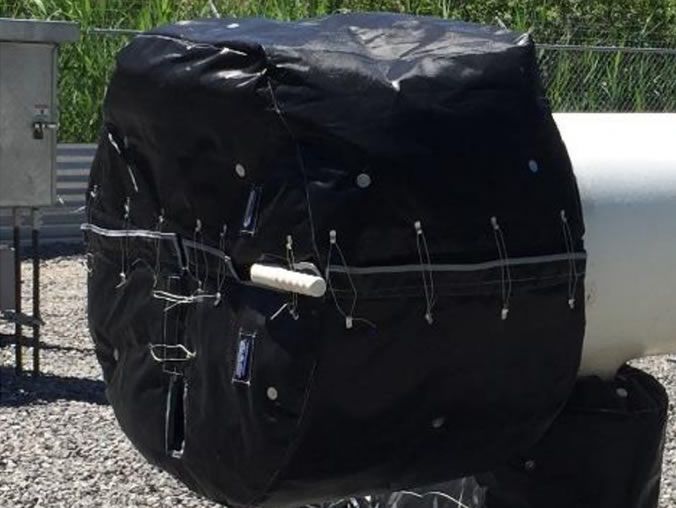SHANNON SAFETY SPRAY SHIELD
SSS-500-AAAS
INTRODUCTION
Shannon Safety Shields are a high quality custom fit protective composite jacketing designed to address potential flange rupture leaks, deflect potential effluent, and contain liquid discharge, protecting the surrounding work environment. Flexible and easily installed, these Safety Shields are designed to be removed and reinstalled for quick access and easy equipment serviceability.
Shannon Safety Shields are weather and chemical resistant. All Shannon Safety Shields are a CAD designed, CNC produced, and engineered for lasting performance.
Common Applications and Industries:
Applications : Valves, Flanges, Equipment & Equipment Heads, Instrumentation and Complex Surfaces that otherwise are left untreated. Industries include Chemical and Petro Chemical Processing Plants
Engineering Standards
Shannon Safety Shields follow the ASTM D3786 Mullen Burst Test per ASTM F1138 (Spray Shields for Mechanical Joints)
Applications and Markets:
Applications include: Valves, Flanges, Equipment & Equipment Heads, Instrumentation and Complex Surfaces that otherwise are left untreated. Markets include: Chemical and Petro Chemical Processing Plants.
Service Temperature:
This design is to act as a Thermal Barrier with a maximum service temperature of 260˚C (500˚F).
Product Components
The Outer to Inner Jacketing will be as follows: 1 (each) Layer – 17.7 oz/yd² (601g/m²) Silicone Impregnated Fiberglass Cloth 3 (each) Layers – 21.5 oz/yd² (731g/m²) Aluminum Foil Laminate Fiberglass Cloth 4 (each) layers of fabric are sewn together, producing a Self-Contained Fabric Sleeve.

Pig Launcher – Head
SHANNON SPRAY SHIELD THICKNESS TO SURFACE CONDITION
(OPTIONAL) TEMPERATURE REFERENCE:
Operating Temp |
Thickness |
Surface Temp |
Thickness |
Surface Temp |
Thickness |
Surface Temp |
|---|---|---|---|---|---|---|
| 121˚ C (250˚ F) | 25 mm( 1″) | 37.9˚ C (100.2˚ F) | 40 mm( 1.5″) | 33.3˚ C (92.0˚ F) | 50 mm (2″) | 30.8˚ C (87.4˚ F) |
| 149˚ C (300˚ F) | 25 mm( 1″) | 42.6˚ C (108.6˚ F) | 40 mm( 1.5″) | 36.8˚ C (98.2˚ F) | 50 mm (2″) | 33.5˚ C (92.3˚ F) |
| 177˚ C (350˚ F) | 25 mm( 1″) | 47.3 ˚C (117.2˚ F ) | 40 mm( 1.5″) | 40.3˚ C (104.6˚ F ) | 50 mm (2″) | 36.3˚ C (97.4˚ F ) |
| 204˚ C (400˚ F) | 25 mm( 1″) | 52.2˚ C (126.0˚ F) | 40 mm( 1.5″) | 44.0 ˚C (111.2˚ F) | 50 mm (2″) | 39.3 ˚C (102.7˚ F) |
| 232˚ C (450˚ F) | 25 mm( 1″) | 57.2˚ C (135.1˚ F) | 40 mm( 1.5″) | 47.8 ˚C (118.0˚ F) | 50 mm (2″) | 42.3 ˚C (108.2˚ F) |
| 260˚ C (500˚ F) | 25 mm( 1″) | 62.5˚ C (144.5˚ F) | 40 mm( 1.5″) | 51.7 ˚C (125.1˚ F) | 50 mm (2″) | 45.5 ˚C (113.9˚ F) |
* The above referenced Cold Face Surface Temperatures should be used as guidelines for blanket insulation thickness design.
* The Cold Face Surface Temperature of the blanket should approach surrounding ambient temperature conditions.
* The economic thickness of the blanket should consider blanket cost, thermal performance and blanket design constraints.
* Heat loss calculations are based on a 21.1˚ C (70˚ F) ambient temperature using a flat surface condition.
